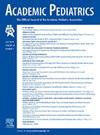Simulation-Based Training Improves Developmental Hip Dysplasia Examination and Diagnosis Skills on Newborns
IF 3
3区 医学
Q1 PEDIATRICS
引用次数: 0
Abstract
Objective
Examination maneuvers used to diagnose developmental hip dysplasia (DDH) translate poorly to video and written curricula. This poses a challenge to teaching the infant hip exam to orthopedic, family medicine, and pediatric trainees. This work investigated the impact of the MiHip simulation-based training program on residents’ knowledge, confidence, and exam skills in the simulated setting, and translation of these skills to the clinical setting.
Methods
Fifty-four pediatric (n = 39) and family medicine (n = 15) residents participated in a non-randomized, stepped-wedge study during 2–4 week newborn rotations. Residents participated in simulation-based training facilitated by a pediatric orthopedic surgeon. Prior to and following training, residents completed a 10-item quiz and reported their confidence toward their DDH skills. Residents’ and attendings’ hip exam diagnoses were captured on 1063 newborns. Residents’ knowledge, confidence, and DDH diagnosis sensitivity were compared pre- and post-training. Chart analysis of 21 newborns that underwent a hip ultrasound compared residents’ and practicing physicians’ diagnoses’ agreement with ultrasound findings.
Results
Following training, residents’ knowledge, confidence and diagnosis skills improved modestly, P < 0.001. In the clinical setting, residents’ confidence (P < 0.001) and skill improved for residents with (sensitivity Δ = .29) and without (Δ = .18) previous simulation-based training experience. Resident diagnoses demonstrated higher agreement with hip ultrasounds than practicing primary care physicians, (Mtrainee = 88.9%, MPCP = 25.0%, P = 0.003, φ = .63).
Conclusion
The hands-on training with the MiHip simulator improved resident knowledge and DDH examination confidence, and ultimately, improved diagnostic accuracy in the clinical setting. Further work is required to assess the larger clinical impact on orthopedic referral rates.
求助全文
约1分钟内获得全文
求助全文
来源期刊

Academic Pediatrics
PEDIATRICS-
CiteScore
4.60
自引率
12.90%
发文量
300
审稿时长
60 days
期刊介绍:
Academic Pediatrics, the official journal of the Academic Pediatric Association, is a peer-reviewed publication whose purpose is to strengthen the research and educational base of academic general pediatrics. The journal provides leadership in pediatric education, research, patient care and advocacy. Content areas include pediatric education, emergency medicine, injury, abuse, behavioral pediatrics, holistic medicine, child health services and health policy,and the environment. The journal provides an active forum for the presentation of pediatric educational research in diverse settings, involving medical students, residents, fellows, and practicing professionals. The journal also emphasizes important research relating to the quality of child health care, health care policy, and the organization of child health services. It also includes systematic reviews of primary care interventions and important methodologic papers to aid research in child health and education.
 求助内容:
求助内容: 应助结果提醒方式:
应助结果提醒方式:


